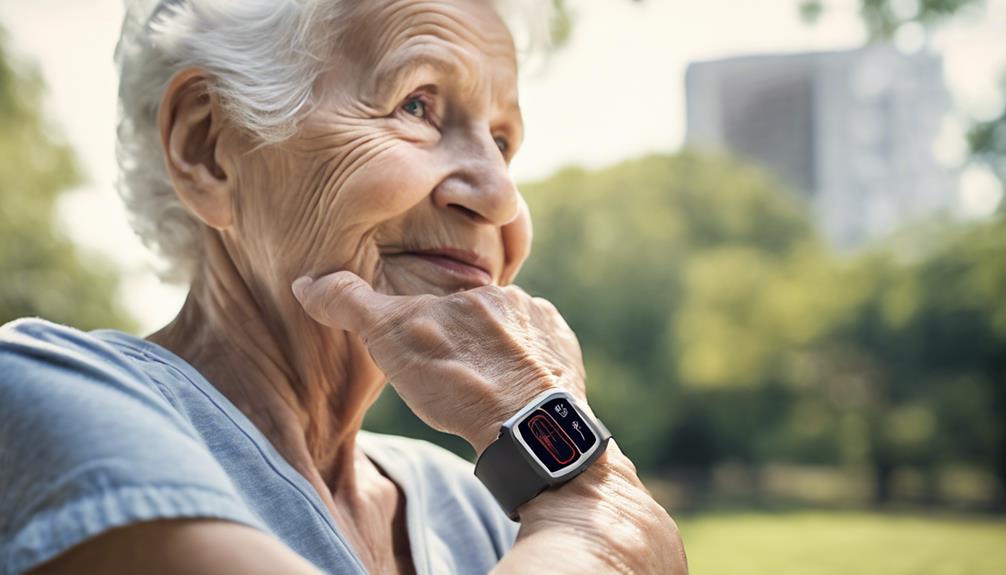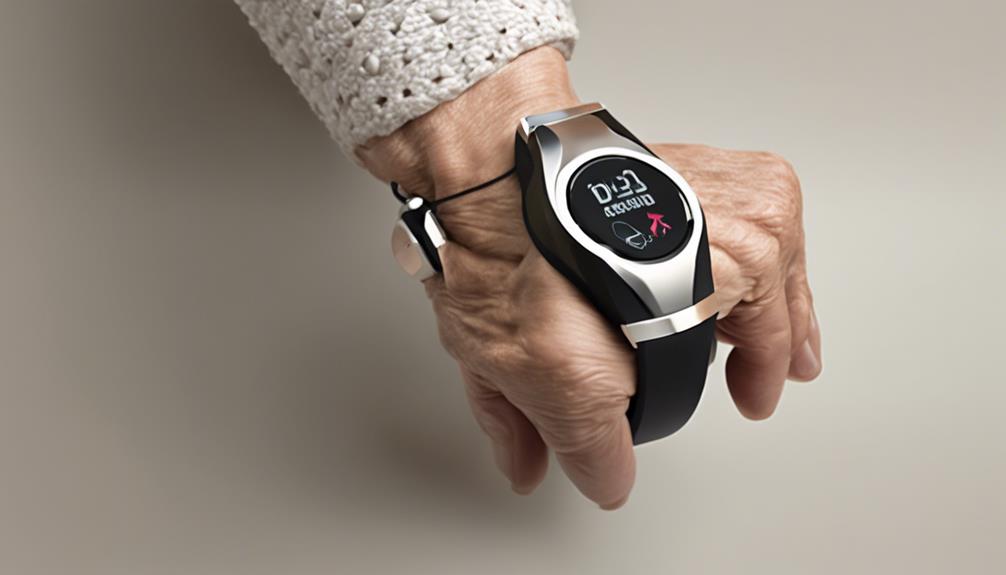Some individuals may question the need for using fixed tracking bracelets for people with dementia. However, these devices are essential for ensuring the safety of those who are at risk of wandering.
Imagine a world where caregivers can have peace of mind knowing their loved ones are safe even if they wander off unexpectedly.
The technology behind these bracelets not only ensures the wearer's safety but also provides a sense of security for families and caregivers.
Key Takeaways
- Essential for caregivers with constant monitoring and peace of mind.
- GPS technology provides real-time location data and enhances safety.
- Proactive approach to safety and well-being with durable materials.
- Consider patient involvement, secure clasp, sizing, and crucial factors for selection.
Benefits of Non-Removable Tracking Bracelets
We find that non-removable tracking bracelets offer essential benefits for caregivers of dementia patients, providing constant monitoring and peace of mind. These bracelets are specifically designed to ensure the safety and security of dementia patients while integrating seamlessly with mobile technology for caregivers' convenience. Made from durable materials, they can withstand the rigors of daily use, guaranteeing long-lasting performance.
The continuous tracking capabilities of non-removable bracelets are invaluable, allowing caregivers to monitor their loved ones at all times. This feature not only enhances the safety of dementia patients but also provides reassurance to caregivers, knowing they can quickly locate their loved ones if needed.
The reliable tracking solutions offered by these bracelets make them indispensable tools in managing the care of individuals with dementia, offering a sense of security and peace of mind to both caregivers and their loved ones.
How GPS Technology Enhances Safety

Non-removable tracking bracelets equipped with GPS technology significantly enhance the safety of dementia patients by providing real-time location data for quick responses in case of wandering incidents. The integration of GPS technology in these bracelets offers various benefits that cater to the needs of both patients and caregivers:
- Geo-fencing: Geo-fencing features in GPS tracking bracelets create virtual boundaries, ensuring that alerts are triggered if the patient moves outside designated safe zones.
- Remote Tracking: Caregivers can track the movements of dementia patients remotely through mobile applications, allowing for immediate intervention in case of emergencies.
- Continuous Monitoring: Non-removable GPS tracking bracelets provide continuous monitoring solutions, guaranteeing the safety and security of dementia patients at all times.
These features not only enhance the safety of dementia patients but also provide peace of mind to caregivers, knowing they can quickly locate their loved ones when needed.
Impact on Dementia Patient Care
Enhancing dementia patient care through the utilization of GPS-enabled tracking bracelets offers a proactive approach to ensuring their safety and well-being.
Non-removable tracking bracelets provide constant monitoring, integrating seamlessly with mobile technology to offer caregivers enhanced functionality and peace of mind. The durability of these bracelets ensures they can withstand the rigors of daily use, contributing to uninterrupted care for dementia patients.
Real-time tracking and geofence alerts play a crucial role in quickly locating patients in case of wandering incidents, improving response times and overall safety. By utilizing GPS tracking technology, caregivers can provide better supervision and support to dementia patients, leading to more effective care management strategies.
These bracelets serve as essential tools in the caregiving process, facilitating a higher level of care for individuals with dementia and granting caregivers the ability to offer assistance promptly and efficiently.
Considerations for Caregivers

Considering the challenges faced by caregivers in ensuring the safety and well-being of dementia patients, understanding key considerations when implementing non-removable tracking bracelets can greatly aid in providing effective care.
When choosing a non-removable tracking bracelet for a dementia patient, there are crucial factors to keep in mind:
- Patient Involvement: Engage the patient in selecting the bracelet design to foster a sense of ownership and increase their willingness to wear it.
- Secure Clasp: Opt for a bracelet with a secure clasp that requires two hands to open, enhancing safety measures.
- Sizing Instructions: Follow specific sizing instructions to ensure the bracelet fits well, balancing comfort and security on the patient's wrist.
Future of Wearable Tracking Devices
Looking ahead, wearable tracking devices for dementia patients are poised to revolutionize the way caregivers monitor and ensure the safety of their loved ones. These devices offer a range of advanced features tailored to meet the specific needs of dementia patients, providing real-time monitoring, geofencing, and non-removable GPS integration for continuous tracking. In addition to these capabilities, the future of wearable tracking devices includes two-way communication, fall detection, and SOS alerts for immediate assistance in case of emergencies. Designed for comfortable wear, these devices aim to seamlessly integrate into the daily lives of dementia patients without causing any discomfort. The evolution of wearable tracking devices signifies a significant step towards enhancing the well-being and security of dementia patients, offering caregivers a reliable solution for constant monitoring and ensuring peace of mind. Below is a visual representation of the key features of future wearable tracking devices for dementia patients:
| Features | Description |
|---|---|
| Real-time Monitoring | Continuous tracking of the patient's location |
| Geofencing | Setting up virtual boundaries for safety |
| Two-way Communication | Allowing communication between the wearer and caregivers |
Frequently Asked Questions
What Is the Best Tracker for Someone With Dementia?
For someone with dementia, the best tracker should have:
- GPS for locating them if they wander
- An SOS button for emergencies
- Comfortable, durable design
- Long battery life
- Secure yet easy-to-wear features
Compatibility with caregiver apps is vital for constant monitoring. The tracker should serve its purpose effectively, providing peace of mind for caregivers and safety for the individual.
What Are 3 Things to Never Do With Your Loved One With Dementia?
When caring for a loved one with dementia, it's crucial to remember what not to do.
Firstly, avoid arguing or rushing them, as it can lead to frustration and confusion.
Secondly, never ignore their emotions or overwhelm them with choices, as it can cause feelings of isolation or decision-making difficulties.
Lastly, refrain from physically restraining or forcing them, as it can escalate distress.
Patience and understanding are key in providing compassionate care.
Can You Put a Tracker on a Person With Dementia?
Yes, we can place a tracker on a person with dementia to ensure their safety. These trackers are crucial for locating individuals if they wander or get lost. They offer real-time monitoring and geofencing capabilities, providing peace of mind for caregivers.
Experts recommend using these non-removable bracelets with GPS technology to prevent wandering incidents and ensure quick identification during emergencies. Such devices are valuable tools for enhancing the safety and well-being of dementia patients.
How to Keep Elderly Dementia Patients From Getting Out of Bed?
To keep elderly dementia patients from getting out of bed, we can use various tools and strategies, such as bed alarms, motion sensors, pressure-sensitive pads, and adjustable beds with side rails. Additionally, incorporating night lights and ensuring the bed is at a comfortable height can help enhance safety measures. These various interventions aim to prevent falls and ensure the safety and well-being of our loved ones.
It's crucial to create a secure environment that promotes independence while also minimizing risks associated with nighttime movements. By prioritizing their well-being and comfort, we can strive to provide a caring and safe environment that supports their quality of life.
Conclusion
In conclusion, non-removable tracking bracelets for dementia patients offer a sense of security and peace of mind for caregivers and loved ones.
By utilizing GPS technology, these bracelets provide essential support in case of emergencies, ensuring that crucial medical information is always accessible.
As we continue to explore the future of wearable tracking devices, we can enhance the safety and well-being of individuals with dementia, making a positive impact on their quality of care.









